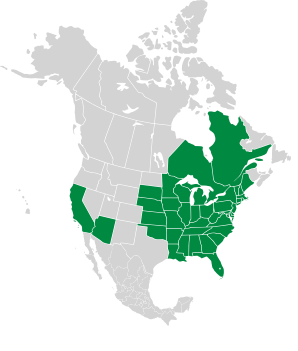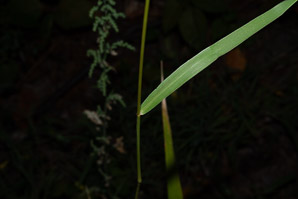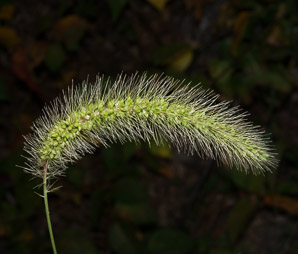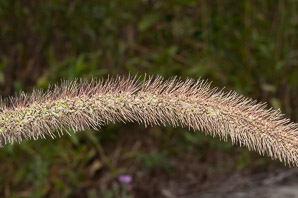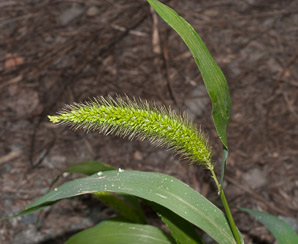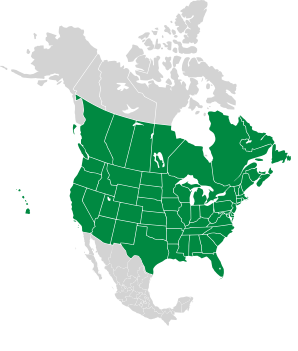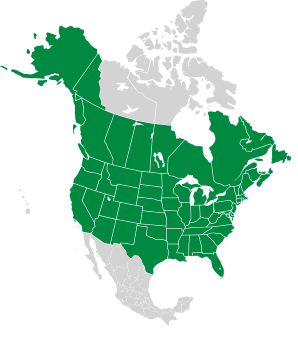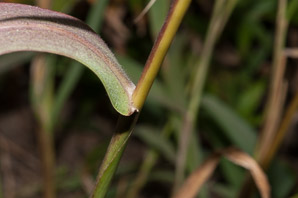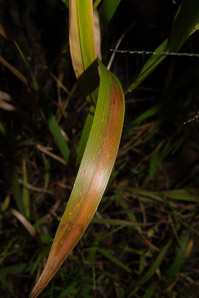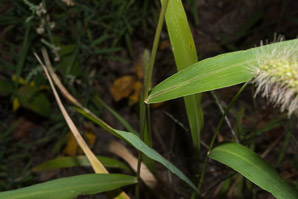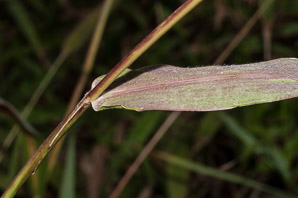
|
Setaria faberi Herrm. Giant foxtail
Giant foxtail is not native to North America, but it is now widespread. In some states it is considered an invasive species because it competes with several crops. Identification: Plants are 2-5′ (60-152 cm) tall, with multiple stems. The grass blades alternate, reaching up to 1′ (38 cm) long and ¾″ (1.9 cm) wide. They are not very stiff, often drooping. Upper leaf surfaces usually have scattered fine, stiff, bristled hairs, but they may also be smooth. Leaf blade edges have tiny teeth that make them feel rough. At the base of each grass blade, just above where it connects to the stem, there is a ringlike tuft of white hairs up to ⅛″ (3 mm) long. Stem tops have a panicle—the "foxtail"—up to 7″ (17 cm) long. Bristly and usually somewhat bent under its own weight, the flowerheads begin green, becoming light brown over time. |
9/19/2013 · Harvard, Massachusetts · ≈ 8 × 6″ (20 × 14 cm) 9/19/2013 · Harvard, Massachusetts · ≈ 8 × 6″ (20 × 14 cm) |
||||||||||||||||||||||||||||
|
Here are the foxtails: | |||||||||||||||||||||||||||||
| You are here Setaria faberi |
Setaria pumila |
Setaria viridis |
|||||||||||||||||||||||||||
|---|---|---|---|---|---|---|---|---|---|---|---|---|---|---|---|---|---|---|---|---|---|---|---|---|---|---|---|---|---|
| Common Name |  |
 |
 |
||||||||||||||||||||||||||
| Plant | Plants are 2-5′ (60-152 cm) tall, the largest foxtails, with multiple stems. The grass blades alternate, reaching up to 1′ (38 cm) long and ¾″ (1.9 cm) wide. | Plants grow in clumps to heights of 3′ (1 m). | Plants grow in clumps with erect stems up to 3′ (1 m) high. | ||||||||||||||||||||||||||
| Flowers | Flowerheads are up to 7″ (17 cm) long. Bristly and drooping under its own weight, they are green to light brown or purplish over time.
|
¾-6″ (2-15 cm) long × ⅜″ (1 cm) in diameter, erect. The flowerhead is made up of spikelets with bristles that appear yellow at maturity. It blooms from June through December.
|
Green panicle up to 6″ (15 cm) in length and ¼-⅝″ (8.5-16 mm) around, usually erect, sometimes slightly nodding.
|
||||||||||||||||||||||||||
| Leaves | Not very stiff, often drooping. Upper leaf surfaces usually have scattered fine, stiff, bristled hairs, but they may also be smooth. Leaf blade edges have tiny teeth that make them feel rough. At the base of each grass blade, just above where it connects to the stem, there is a ringlike tuft of white hairs up to ⅛″ (3 mm) long. | Grass blades are flat or sometimes "keeled," 4-12″ (10-30 cm) by ⅛-½″ (5-12 mm). Just above the point where the grass blade attaches to the stem, there are a lot of small hairs (ligule), on the inside of the blade. | Leaf blades are medium dull green, rough but hairless (except sometimes near the edges), and up to 1′ (40 cm) × ⅞″ (2.5 cm). | ||||||||||||||||||||||||||
| Range/ Zones |
|
|
|
||||||||||||||||||||||||||
| Habitats | Meadows, fields, landfills, mined land, construction sites, vacant lots, yard boundaries, gardens, railroads, roadsides, and waste land. | Roadsides, ditch banks, fields, pastures, cropland, orchards, vineyards, gardens, turf, disturbed sites. | Margins of woods, upland prairies, streambanks, pond margins, pastures, fields, lawns, cultivated areas, disturbed sites, roadsides, railroads. | ||||||||||||||||||||||||||
| Type | Wild | Wild | Wild | ||||||||||||||||||||||||||
| Occurrence | Common, sometimes invasive. | Fairly common | Common | ||||||||||||||||||||||||||
Online References:
The Virginia Tech Weed Identification Guide
a book entitled Giant Foxtail (PDF)
References:
Uva, Richard H.; Neal, Joseph C.; DiTomaso, Joseph M., Weeds of the Northeast, Comstock Publishing Associates, 1997, p. 82 (good comparison between giant
Unknown Reference!
9/24/2010 · Nissitissit River Wildlife Management Area, Pepperell, Massachusetts · ≈ 4½ × 3″ (11 × 7.9 cm) ![]() ID is uncertain
ID is uncertain 
9/19/2013 · Harvard, Massachusetts · ≈ 6 × 8″ (14 × 20 cm) 
9/19/2013 · Harvard, Massachusetts · ≈ 8 × 6″ (20 × 14 cm) 
Setaria faberi description by Thomas H. Kent, last updated 5 Oct 2021.
© FloraFinder.org. All rights reserved.
9/19/2013 · Harvard, Massachusetts · ≈ 6 × 8″ (14 × 20 cm) 
9/24/2010 · Nissitissit River Wildlife Management Area, Pepperell, Massachusetts · ≈ 8 × 5″ (19 × 13 cm) ![]() ID is uncertain
ID is uncertain 
9/24/2010 · Nissitissit River Wildlife Management Area, Pepperell, Massachusetts · ≈ 5 × 3½″ (13 × 9.2 cm) ![]() ID is uncertain
ID is uncertain 
Range:
